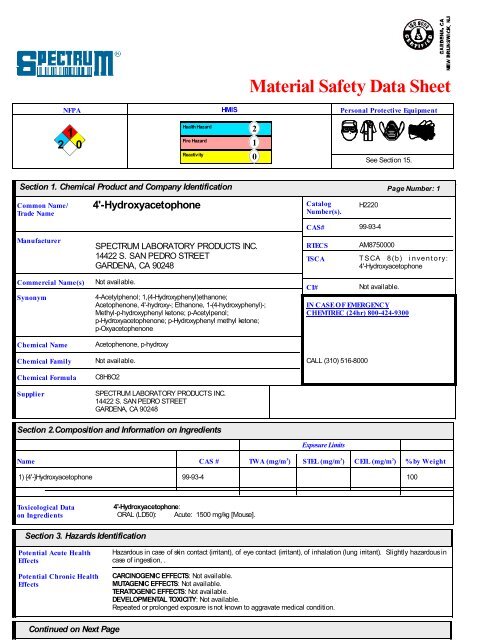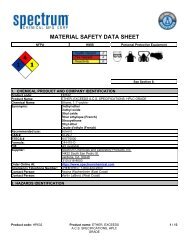MSDS - Spectrum Chemical
MSDS - Spectrum Chemical
MSDS - Spectrum Chemical
Create successful ePaper yourself
Turn your PDF publications into a flip-book with our unique Google optimized e-Paper software.
Material Safety Data SheetNFPA HMIS Personal Protective Equipment12 0Health HazardFire HazardReactivity210See Section 15.Section 1. <strong>Chemical</strong> Product and Company IdentificationCommon Name/Trade NameManufacturer4'-HydroxyacetophoneSPECTRUM LABORATORY PRODUCTS INC.14422 S. SAN PEDRO STREETGARDENA, CA 90248CatalogNumber(s).CAS#RTECSTSCAH222099-93-4AM8750000Page Number: 1T SCA 8 (b ) i n ve n t o ry:4'-HydroxyacetophoneCommercial Name(s)Synonym<strong>Chemical</strong> Name<strong>Chemical</strong> Family<strong>Chemical</strong> FormulaSupplierNot available.4-Acetylphenol; 1,(4-Hydroxyphenyl)ethanone;Acetophenone, 4'-hydroxy-; Ethanone, 1-(4-hydroxyphenyl)-;Methyl-p-hydroxyphenyl ketone; p-Acetylpenol;p-Hydroxyacetophenone; p-Hydroxyphenyl methyl ketone;p-OxyacetophenoneAcetophenone, p-hydroxyNot available.C8H8O2SPECTRUM LABORATORY PRODUCTS INC.14422 S. SAN PEDRO STREETGARDENA, CA 90248CI#CALL (310) 516-8000Not available.IN CASE OF EMERGENCYCHEMTREC (24hr) 800-424-9300Section 2.Composition and Information on IngredientsNameCAS #Exposure LimitsTWA (mg/m 3 ) STEL (mg/m 3 ) CEIL (mg/m 3 ) % by Weight1) {4'-}Hydroxyacetophone 99-93-4 100Toxicological Dataon Ingredients4'-Hydroxyacetophone:ORAL (LD50): Acute: 1500 mg/kg [Mouse].Section 3. Hazards IdentificationPotential Acute HealthEffectsPotential Chronic HealthEffectsHazardous in case of skin contact (irritant), of eye contact (irritant), of inhalation (lung irritant). Slightly hazardous incase of ingestion, .CARCINOGENIC EFFECTS: Not available.MUTAGENIC EFFECTS: Not available.TERATOGENIC EFFECTS: Not available.DEVELOPMENTAL TOXICITY: Not available.Repeated or prolonged exposure is not known to aggravate medical condition.Continued on Next Page
4'-Hydroxyacetophone Page Number: 2Section 4. First Aid MeasuresEye ContactSkin ContactSerious Skin ContactInhalationSerious InhalationCheck for and remove any contact lenses. In case of contact, immediately flush eyes with plenty of water for at least15 minutes. Cold water may be used. Get medical attention.In case of contact, immediately flush skin with plenty of water. Cover the irritated skin with an emollient. Removecontaminated clothing and shoes. Cold water may be used.Wash clothing before reuse. Thoroughly clean shoesbefore reuse. Get medical attention.Wash with a disinfectant soap and cover the contaminated skin with an anti-bacterial cream. Seek immediatemedical attention.If inhaled, remove to fresh air. If not breathing, give artificial respiration. If breathing is difficult, give oxygen. Getmedical attention.Not available.IngestionSerious IngestionDo NOT induce vomiting unless directed to do so by medical personnel. Never give anything by mouth to anunconscious person. If large quantities of this material are swallowed, call a physician immediately. Loosen tightclothing such as a collar, tie, belt or waistband.Not available.Section 5. Fire and Explosion DataFlammability of the ProductAuto-Ignition TemperatureFlash PointsFlammable LimitsProducts of CombustionFire Hazards in Presence ofVarious SubstancesExplosion Hazards inPresence of VariousSubstancesFire Fighting Mediaand InstructionsSpecial Remarks onFire HazardsSpecial Remarks onExplosion HazardsMay be combustible at high temperature.Not available.CLOSED CUP: 166°C (330.8°F).Not available.These products are carbon oxides (CO, CO2).Slightly flammable to flammable in presence of heat.Risks of explosion of the product in presence of mechanical impact: Not available.Risks of explosion of the product in presence of static discharge: Not available.SMALL FIRE: Use DRY chemical powder.LARGE FIRE: Use water spray, fog or foam. Do not use water jet.As with most organic solids, fire is possible at elevated temperaturesFine dust dispersed in air in sufficient concentrations, and in the presence of an ignition source is a potential dustexplosion hazard.Section 6. Accidental Release MeasuresSmall SpillLarge SpillUse appropriate tools to put the spilled solid in a convenient waste disposal container. Finish cleaning by spreadingwater on the contaminated surface and dispose of according to local and regional authority requirements.Use a shovel to put the material into a convenient waste disposal container. Finish cleaning by spreading water onthe contaminated surface and allow to evacuate through the sanitary system.Continued on Next Page
4'-Hydroxyacetophone Page Number: 3Section 7. Handling and StoragePrecautionsStorageKeep away from heat. Keep away from sources of ignition. Ground all equipment containing material. Do notingest. Do not breathe dust. Wear suitable protective clothing. If ingested, seek medical advice immediately andshow the container or the label. Avoid contact with skin and eyes. Keep away from incompatibles such as oxidizingagents, alkalis.Keep container tightly closed. Keep container in a cool, well-ventilated area.Section 8. Exposure Controls/Personal ProtectionEngineering ControlsPersonal ProtectionUse process enclosures, local exhaust ventilation, or other engineering controls to keep airborne levels belowrecommended exposure limits. If user operations generate dust, fume or mist, use ventilation to keep exposure toairborne contaminants below the exposure limit.Splash goggles. Lab coat. Dust respirator. Be sure to use an approved/certified respirator or equivalent. Gloves.Personal Protection in Caseof a Large SpillExposure LimitsSplash goggles. Full suit. Dust respirator. Boots. Gloves. A self contained breathing apparatus should be used toavoid inhalation of the product. Suggested protective clothing might not be sufficient; consult a specialist BEFOREhandling this product.Not available.Section 9. Physical and <strong>Chemical</strong> PropertiesPhysical state andappearanceMolecular WeightpH (1% soln/water)Solid. (Crystalline powder. Crystals solid.)136.15 g/moleNot available.OdorTasteColorNot available.Not available.White. Off-white.Boiling Point147°C (296.6°F) - 148 at 3 mmHgMelting Point104°C (219.2°F) - 111 C.Critical TemperatureNot available.Specific Gravity1.109 (Water = 1)Vapor PressureNot applicable.Vapor DensityNot available.VolatilityNot available.Odor ThresholdNot available.Water/Oil Dist. Coeff.Not available.Ionicity (in Water)Not available.Dispersion PropertiesSee solubility in water.SolubilitySoluble in cold water.Section 10. Stability and Reactivity DataStabilityInstability TemperatureConditions of InstabilityIncompatibility with varioussubstancesThe product is stable.Not available.Excess heat, incompatible materials, dust generation.Reactive with oxidizing agents, alkalis.Continued on Next Page
4'-Hydroxyacetophone Page Number: 4CorrosivityNon-corrosive in presence of glass.Special Remarks onReactivitySpecial Remarks onCorrosivityPolymerizationAlso incompatible with acid chlorides and acid anhydrides.Not available.Will not occur.Section 11. Toxicological InformationRoutes of EntryToxicity to AnimalsChronic Effects on HumansOther Toxic Effects onHumansSpecial Remarks onToxicity to AnimalsSpecial Remarks onChronic Effects on HumansSpecial Remarks on otherToxic Effects on HumansInhalation. Ingestion.Acute oral toxicity (LD50): 1500 mg/kg [Mouse].Not available.Hazardous in case of skin contact (irritant), of inhalation (lung irritant).Slightly hazardous in case of ingestion, .Not available.May cause adverse reproductive effects based on animal test data. No human data foundAcute Potential Health Effects:Skin: Causes skin irritation.Eyes: Causes eye irritation.Inhalation: Can cause respiratory tract irritation.Ingestion: May be harmful if swallowed. May cause digestive/gastrointestinal tract irritation.Section 12. Ecological InformationEcotoxicityBOD5 and CODProducts of BiodegradationToxicity of the Productsof BiodegradationSpecial Remarks on theProducts of BiodegradationNot available.Not available.Possibly hazardous short term degradation products are not likely. However, long term degradation products mayarise.The products of degradation are less toxic than the product itself.Not available.Section 13. Disposal ConsiderationsWaste DisposalWaste must be disposed of in accordance with federal, state and local environmental controlregulations.Section 14. Transport InformationDOT ClassificationIdentificationNot a DOT controlled material (United States).Not applicable.Special Provisions forTransportNot applicable.Continued on Next Page
4'-Hydroxyacetophone Page Number: 5DOT (Pictograms)Section 15. Other Regulatory Information and PictogramsFederal and StateRegulationsCaliforniaProposition 65WarningsOther RegulationsTSCA 8(b) inventory: 4'-HydroxyacetophoneCalifornia prop. 65: This product contains the following ingredients for which the State of California has found tocause cancer which would require a warning under the statute: No products were found.California prop. 65: This product contains the following ingredients for which the State of California has found tocause birth defects which would require a warning under the statute: No products were found.EINECS: This product is on the European Inventory of Existing Commercial <strong>Chemical</strong> Substances (EINECS No.202-802-8).Canada: Listed on Canadian Domestic Substance List (DSL).China: Listed on National Inventory.Japan: Listed on National Inventory (ENCS).Korea: Not listed on National Inventory (KECI).Philippines: Listed on National Inventory (PICCS).Australia: Listed on AICS.Other ClassificationsWHMIS (Canada)CLASS D-2B: Material causing other toxic effects (TOXIC).DSCL (EEC)R22- Harmful if swallowed.R36/37/38- Irritating to eyes, respiratorysystem and skin.S26- In case of contact with eyes, rinseimmediately with plenty of water and seekmedical advice.S37/39- Wear suitable gloves and eye/faceprotection.S46- If swallowed, seek medical adviceimmediately and show this container or label.HMIS (U.S.A.)Health HazardFire HazardReactivity210National Fire ProtectionAssociation (U.S.A.)Health210FlammabilityReactivityPersonal ProtectionESpecific hazardWHMIS (Canada)(Pictograms)DSCL (Europe)(Pictograms)TDG (Canada)(Pictograms)ADR (Europe)(Pictograms)Continued on Next Page
4'-Hydroxyacetophone Page Number: 6Protective EquipmentGloves.Lab coat.Dust respirator. Be sure to use anapproved/certified respirator or equivalent.Wear appropriate respirator when ventilationis inadequate.Splash goggles.Section 16. Other Information<strong>MSDS</strong> CodeReferencesOther SpecialConsiderationsH3334Not available.Not available.Validated by Sonia Owen on 2/3/2009.Verified by Sonia Owen.Printed 3/13/2009.CALL (310) 516-8000Notice to ReaderAll chemicals may pose unknown hazards and should be used with caution. This Material Safety Data Sheet (<strong>MSDS</strong>) applies only to the material as packaged. If this product is combined with other materials,deteriorates, or becomes contaminated, it may pose hazards not mentioned in this <strong>MSDS</strong>. It shall be the user's responsibility to develop proper methods of handling and personal protection based on the actualconditions of use. While this <strong>MSDS</strong> is based on technical data judged to be reliable, <strong>Spectrum</strong> Quality Products, Inc. assumes no responsibility for the completeness or accuracy of the information contained herein.
















